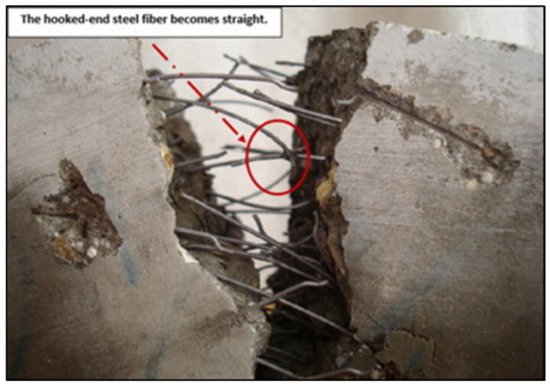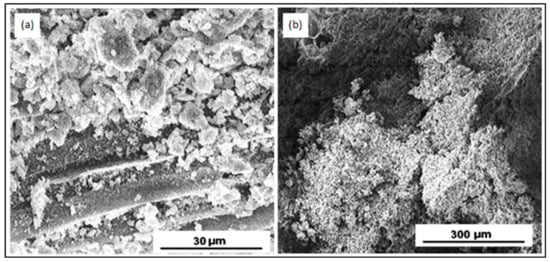In cement composites, usually, reinforcement is provided to restrict the crack development and their further propagation under service conditions.
- cementitious composites
- fracture energy
- pyrolysis
- biochar
- high performance
1. Overview
In cement composites, usually, reinforcement is provided to restrict the crack development and their further propagation under service conditions. Typically, reinforcements utilized in cementitious composites range from nanometer scale to millimeter scale by using nano-, micro-, and millimeter-sized fibers and particles. These reinforcements provide the crack arresting mechanisms at the nano/microscale and restrict the growth of the cracks under service loads, but usually, the synthesis of nano/microfibers, and afterward their dispersion in the cementitious materials, pose difficulty, thus limiting their vast application in the construction industry. Carbonaceous inerts are green materials since they are capable of capturing and storing carbon, thus limiting the emission of CO2 to the atmosphere. In the present study, a comprehensive review of the synthesis of low cost and environmentally friendly nano/micro carbonaceous inerts from pyrolysis of different agricultural/industrial wastes, and afterward, their application in the cementitious materials for producing high performance cementitious composites is presented, which have the potential to be used as nano/micro reinforcement in the cementitious matrix.
2. Background


3. Conclusions
References
- Khitab, A.; Anwar, W. Classical Building Materials. In Advanced Research on Nanotechnology for Civil Engineering Applications; IGI Global: Hershey, PA, USA, 2016; pp. 1–27.
- Gillani, S.S.-H.; Khitab, A.; Ahmad, S.; Khushnood, R.A.; Ferro, G.A.; Saleem Kazmi, S.M.; Qureshi, L.A.; Restuccia, L. Improving the Mechanical Performance of Cement Composites by Carbon Nanotubes Addition. Procedia Struct. Integr. 2017, 3, 11–17.
- Khitab, A.; Ahmad, S.; Khushnood, R.A.; Rizwan, S.A.; Ferro, G.A.; Restuccia, L.; Ali, M.; Mehmood, I. Fracture Toughness and Failure Mechanism of High Performance Concrete Incorporating Carbon Nanotubes. Frat. Integrita Strutt. 2017, 11.
- Khitab, A.; Arshad, M.T.; Hussain, N.; Tariq, K.; Ali, S.A.; Kazmi, S.M.S.; Munir, M.J. Concrete Reinforced with 0.1 Vol% of Different Synthetic Fibers. Life Sci. J. 2013, 10, 12.
- Abbass, W.; Khan, M.I.; Mourad, S. Evaluation of Mechanical Properties of Steel Fiber Reinforced Concrete with Different Strengths of Concrete. Constr. Build. Mater. 2018, 168, 556–569.
- Fediuk, R.; Mosaberpanah, M.A.; Lesovik, V. Development of Fiber Reinforced Self-Compacting Concrete (FRSCC): Towards an Efficient Utilization of Quaternary Composite Binders and Fibers. Adv. Concr. Constr. 2020, 9, 387–395.
- Pelisser, F.; Neto, A.B.; da Rovere, S.S.; La, H.L.; de Pinto, R.C.A. Effect of the Addition of Synthetic Fibers to Concrete Thin Slabs on Plastic Shrinkage Cracking. Constr. Build. Mater. 2010, 24, 2171–2176.
- Reis, J.M.L. Fracture and Flexural Characterization of Natural Fiber-Reinforced Polymer Concrete. Constr. Build. Mater. 2006, 20, 673–678.
- Kavitha, S.; Kala, T.F. A Review on Natural Fibres in the Concrete. Int. J. Adv. Eng. Technol. 2017, 1, 1–4.
- Eren, Ö.; Marar, K. Effects of Limestone Crusher Dust and Steel Fibers on Concrete. Constr. Build. Mater. 2009, 23, 981–988.
- Tiberti, G.; Minelli, F.; Plizzari, G. Cracking Behavior in Reinforced Concrete Members with Steel Fibers: A Comprehensive Experimental Study. Cem. Concr. Res. 2015, 68, 24–34.
- Pająk, M.; Ponikiewski, T. Flexural Behavior of Self-Compacting Concrete Reinforced with Different Types of Steel Fibers. Constr. Build. Mater. 2013, 47, 397–408.
- Yoo, D.-Y.; Sohn, H.-K.; Borges, P.H.R.; Fediuk, R.; Kim, S. Enhancing the Tensile Performance of Ultra-High-Performance Concrete through Strategic Use of Novel Half-Hooked Steel Fibers. J. Mater. Res. Technol. 2020, 9, 2914–2925.
- Düzgün, O.A.; Gül, R.; Aydin, A.C. Effect of Steel Fibers on the Mechanical Properties of Natural Lightweight Aggregate Concrete. Mater. Lett. 2005, 59, 3357–3363.
- Vandewalle, L. Cracking Behaviour of Concrete Beams Reinforced with a Combination of Ordinary Reinforcement and Steel Fibers. Mater. Struct. 2000, 33, 164–170.
- Alhozaimy, A.M.; Soroushian, P.; Mirza, F. Mechanical Properties of Polypropylene Fiber Reinforced Concrete and the Effects of Pozzolanic Materials. Cem. Concr. Compos. 1996, 18, 85–92.
- Afroughsabet, V.; Ozbakkaloglu, T. Mechanical and Durability Properties of High-Strength Concrete Containing Steel and Polypropylene Fibers. Constr. Build. Mater. 2015, 94, 73–82.
- Song, P.S.; Hwang, S.; Sheu, B.C. Strength Properties of Nylon- and Polypropylene-Fiber-Reinforced Concretes. Cem. Concr. Res. 2005, 35, 1546–1550.
- Ramakrishna, G.; Sundararajan, T. Long-Term Strength and Durability Evaluation of Sisal Fiber Composites. In Durability and Life Prediction in Biocomposites, Fibre-Reinforced Composites and Hybrid Composites; Elsevier: Amsterdam, The Netherlands, 2019; pp. 211–255.
- Bilba, K.; Arsene, M.-A. Silane Treatment of Bagasse Fiber for Reinforcement of Cementitious Composites. Compos. Part. A Appl. Sci. Manuf. 2008, 39, 1488–1495.
- Andiç-Çakir, Ö.; Sarikanat, M.; Tüfekçi, H.B.; Demirci, C.; Erdoǧan, Ü.H. Physical and Mechanical Properties of Randomly Oriented Coir Fiber-Cementitious Composites. Compos. Part. B Eng. 2014, 61, 49–54.
- Khan, M.; Ali, M. Effect of Super Plasticizer on the Properties of Medium Strength Concrete Prepared with Coconut Fiber. Constr. Build. Mater. 2018, 182, 703–715.
- Islam, M.S.; Ahmed, S.J. Influence of Jute Fiber on Concrete Properties. Constr. Build. Mater. 2018, 189, 768–776.
- Restuccia, L.; Ferro, G.A. Nanoparticles from Food Waste: A “Green” Future for Traditional Building Materials. In Proceedings of the 9th International Conference on Fracture Mechanics of Concrete and Concrete Structures, IA-FraMCoS, Berkeley, CA, USA, 28 May 2016.
- Choi, W.C.; Yun, H.D.; Lee, J.Y. Mechanical Properties of Mortar Containing Bio-Char From Pyrolysis. J. Korea Institue Struct. Maint. Insp. 2012, 16, 67–74.
